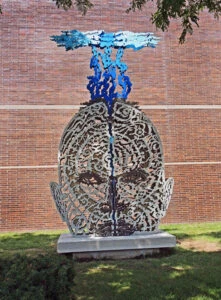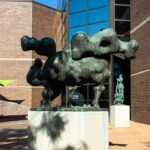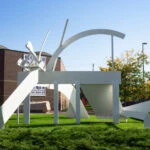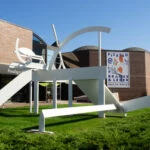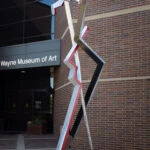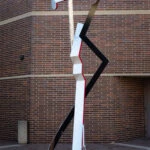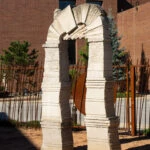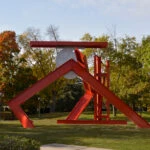Sculpture at FWMoA
Peter Forakis, American, 1927-2009
Quake, painted steel, 1982. Gift of the artist and the ALCOA Foundation on behalf of Rea Magnet Wire Company, 1986.04.
Sculpture in the 1980s had become less organically abstract and more geometric. Weighing four tons, Quake is constructed of fabricated steel painted red. The sculpture consists of an open rectangular plane carefully balanced on end and appears truncated at the top by a bent corner. Joined at its apex, another rectangular plane is set farther back, seemingly in the process of being submerged into the ground.
Dale Enochs, American, b. 1952
There Are Rivers, cut and anodized aluminum and Indiana limestone, 2021
Museum commission with funds provided by the June E. Enoch Collection Fund, 2021.247.
To celebrate its 100th anniversary, FWMoA commissioned a sculpture by Bloomington-based artist Dale Enochs. The anodized aluminum sculpture sits upon a carved limestone base and pays homage to the area’s three rivers as foundational for the development of our community. Enochs paid special attention to the names of the rivers as given by the Miami people, who first settled the area, by including them in a layer of the sculpture.
Carl Emil Milles, Swedish, 1875-1955
The Man and the Unicorn, bronze, 1936
Gift of an anonymous donor, 2006.05.
Carl Emil Milles was a Swedish-American sculptor who taught for many years at the Cranbrook Academy of Art in Michigan. Leaving Michigan for Sweden he left behind numerous sculptural works across the American landscape. The Man and the Unicorn is only one such piece. A more figurative and literal interpretation of the relationship between man and animal, it is a contrast to the nearby Animal in Motion.
Abbott Pattison, American, 1916-1996
Animal in Motion, bronze, 1960
Gift of Mrs. Dorothea Fruechtenicht Brown, 1966.03.
This mass of bronze combines humanistic and animalistic shapes, inextricably linked, and perhaps struggling against each other. These artistic decisions reflect the time in which it was made, when cultural norms were rapidly shifting and social and geopolitical protests were common. This period in art marked a shift from the representational to the more favored abstract styles that would dominate the 1960s and ‘70s.
Darrell Petit, Canadian, b. 1960
Continuum, granite, 2015
Purchase, 2016.128
Sculpted from a single block of granite, this 25-ton sculpture features rough edges that contrast with a smooth, undulating center that refers to the natural flow of water. Its graceful but commanding minimalist form honors the material in its natural beauty while showcasing the artist’s steady, disciplined hand in shaping the stone. Peter Selz, the noted art historian, has said that Petit’s sculpture “animates the environments of nature and the post-minimalist context that contemporary sculpture now inhabits.”
David Black, American, b. 1928
Crossings, Aluminum and white epoxy, 1984
Purchase, 1985.04
Crossings was designed specifically for its location on the south lawn of the Museum. The elegant dynamic forms of Crossings are intended by the artist to create visual associations with the adjacent Museum and Arts United Center and to evoke personal responses in the viewer. In the words of the artist, “Crossings is the point at which actions move from one arena to another: Street to museum, man-made to nature, physical to metaphysical.”
John Mishler
Renewal, 2014, recycled aluminum and copper.
Sculpture with a Purpose Initiative.
Through innovative designs specifically crafted to accommodate bicycle parking, Sculpture with a Purpose encourages the benefits of cycling while enriching the streets with art for everyone to enjoy. It is a tribute to Fort Wayne’s passion, momentum, and innovative spirit. The initiative was part of Purdue Fort Wayne’s 50th anniversary in 2015. During its 50th Celebration, Purdue Fort Wayne permanently enhanced the visual landscape of its campus and community.
Stuart Fink
Station, 1986, pigmented, cast concrete.
Gift of Mr. and Mrs. Tom G. McClain, PC 1992.16.
Station is made of cast concrete, a material the artist turned to as an inexpensive alternative to aluminum. Pigmented in earth tones, Station is one of a series of sculpture based on architectural forms like columns, pediments, arches, and peristyles. Each unique section is a fragment of the whole, some resembling clouds or waves, configured into an unusual and dynamic column.
Cary Shafer
Tilted Arch, 2012, limestone.
Commissioned by the Museum, SC 44.2012.
Tilted Arch is an abstract sculpture made using traditional stone working techniques and is inspired by the classical architecture method of the post and lintel. This method, also seen in Stonehenge, is an ancient engineering technique and is still essential to construction today. Originally a journalism student, Shafer apprenticed under Italian master-carver Vincent Palumbo for four years, learning traditional stone working techniques.
Mark di Suvero
Helmholtz, 1985, painted and stainless steel.
Gift of the artist and the ALCOA Foundation on behalf of Rea Magnet Wire Company, PC 1986.03.
Helmholtz refers to the 19th century German physicist Herman Ludwig Ferdinand Helmholtz, who developed a formula for the distribution of force on a magnetic field. The original concept of Helmholtz included a disk that would hover in a magnetic field several feet above the ground, but di Suvero’s vision preceded his ability to complete the work as planned, as the technology to create a safe magnetic field of the force has not yet been developed. On June 16, 2013, this sculpture was struck by a motorist and severely damaged. It has now been fully restored and reinstalled.


